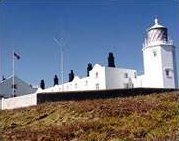
On the tip of the Lizard Peninsula
Lizard Point, TR12 7NT
Tel: (01326) 290202
Email: visitor.centre@trinityhouse.co.uk
Web: www.trinityhouse.co.uk/lighthouses-and-lightvessels/lizard-lighthouse
Map
Lizard Lighthouse is a landfall and coastal mark giving a guide to vessels in passage along the English Channel and warning of the hazardous waters off Lizard Point.
Many stories are told of the activities of wreckers around our coasts, most of which are grossly exaggerated, but small communities occasionally and sometimes officially benefited from the spoils of shipwrecks, and petitions for lighthouses were, in certain cases, rejected on the strength of local opinion; this was particularly true in the South West of England.
The distinctive twin towers of the Lizard Lighthouse mark the most southerly point of mainland Britain. The coastline is particularly hazardous, and from early times the need for a beacon was obvious. Sir John Killigrew, a philanthropic Cornishman, applied for a patent. Apparently, because it was thought that a light on Lizard Point would guide enemy vessels and pirates to a safe landing, the patent was granted with the proviso that the light should be extinguished at the approach of the enemy. Killigrew agreed to erect the lighthouse at his own expense, for a rent of "twenty nobles by the year", for a term of 30 years. Although he was willing to build the tower, he was too poor to bear the cost of maintenance, and intended to fund the project by collecting from ships that passed the point any voluntary contributions that the owners might offer him. In spite of the difficulty of recruiting local labour, the tower was finished by Christmas 1619, and proved a great benefit to mariners. However, the shipowners offered nothing for its upkeep, and the mounting costs of maintenance were bankrupting Killigrew. Thus, in the face of more opposition from Trinity House, James 1st set a fee of one halfpenny a ton on all vessels passing the light. This caused such an uproar from the shipowners that the patent was withdrawn, the light extinguished and the tower demolished.
Applications were made in ensuing years, but it was not until 1748 that Trinity House supported an attempt by Thomas Fonnereau to erect a lighthouse. The building was completed in 1751, and consisted of two towers 65 feet tall, with a cottage built between them, in which an over-looker lay on a sort of couch, with a window on either side commanding a view of the lanterns. When the bellows-blowers relaxed their efforts and the fires dimmed, he would remind them of their duties by a blast from a cow horn. Trinity House assumed responsibility in 1771. The two towers are the ones still standing today a little altered bur substantially the same with six dwellings for lighthouse keepers between them. In 1812 the coal fires were discontinued in favour of Argand oil lights with reflectors which remained in use until 1878 when electric light was installed using generators at the lighthouse. The two electric lights were fixed ones until 1903 when the light in the western tower was discontinued and a single flashing one installed in the eastern tower. The Lizard Lighthouse was automated in 1998, and is now monitored and controlled from the Trinity House Operations Control Centre at Harwich in Essex.
On the 13th July 2009 HRH The Princess Royal officially opened the Lizard Lighthouse Heritage Centre. With the help of a generous grant from the Heritage Lottery Fund, Trinity house has renovated the Engine Room at Lizard Lighthouse, retaining some of the old engines. It now also features new exhibition material, an audio visual room and a number of interactive displays.
The Main exhibit now features Trinity house artefacts previously on display at the National Maritime Museum. These include a magnificent pair of 12 foot light-vessel optics as well as the solid bronze entrance doors from the Bishop Rock Lighthouse smashed through by storm waves! Plus come and see the original hand-operated fire truck that the Lizard Lighthouse keepers kept on standby in the Engine Room!
At the southernmost point of the Lizard Peninsula.
Opening TimesEaster - October Admission Charged |
Cornish Lighthouses Cornwall's Shipwrecks Lizard Peninsula Lizard Point Lizard Village The Coastal Footpath